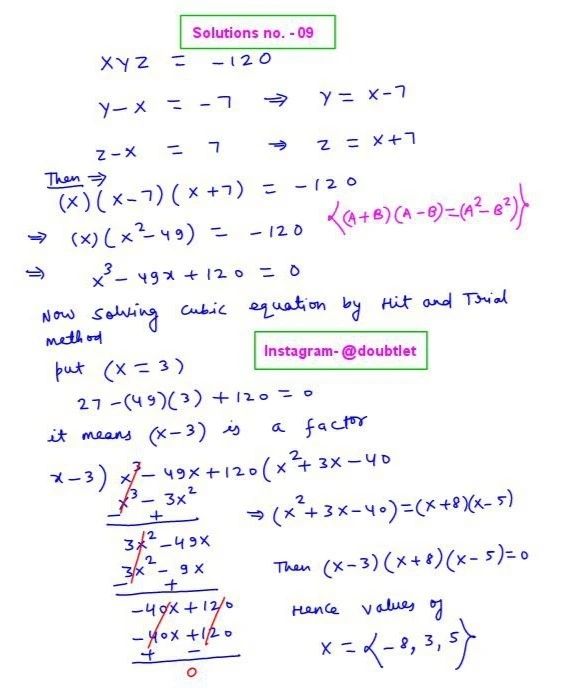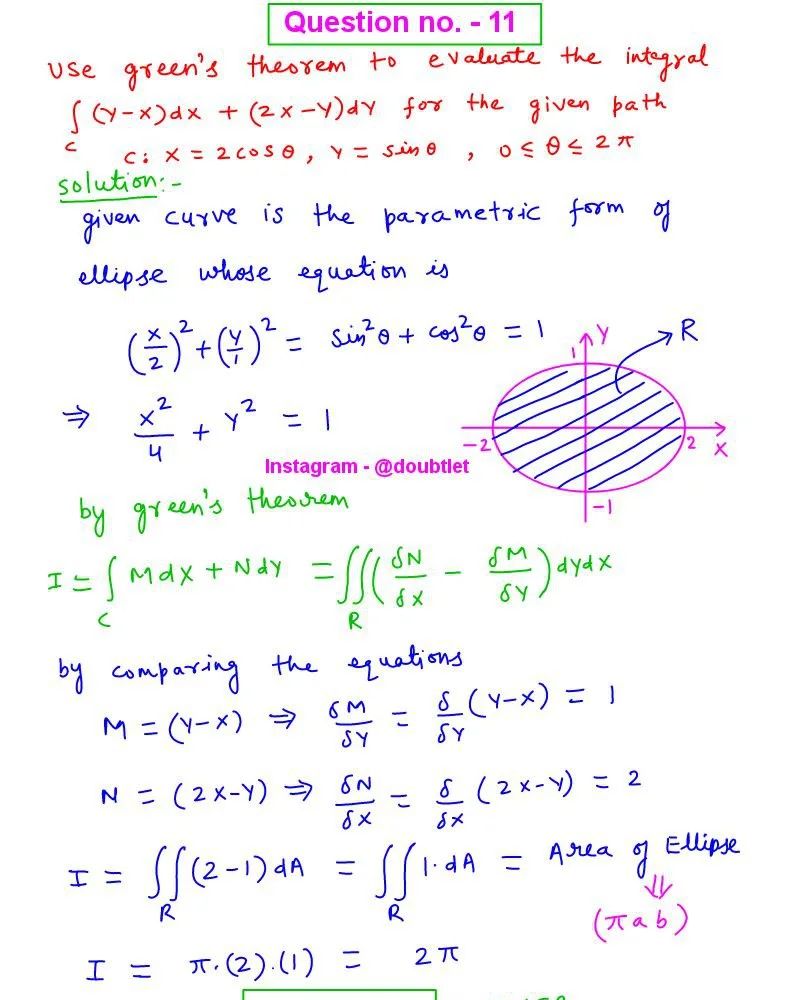









Double integrals are a powerful tool in calculus used to calculate the accumulation of quantities over two-dimensional regions, such as area, volume, and mass. They extend the concept of single integrals to two variables, making them essential for solving problems in physics, engineering, and geometry. Double integrals allow us to compute properties like total area or volume beneath a surface across a defined region.

Neetesh Kumar | October 19, 2024
Share this Page on:
![]()
![]()
![]()
![]()
![]()
- 1. Introduction to the Double Integrals
- 2. What are Double Integrals
- 3. Evaluation of Double Integrals
- 4. Double Integrals Properties
- 5. Double Integrals Rules
- 6. Steps to Solve Double Integrals
- 7. Double Integrals Applications
- 8. Calculation of Area using Double Integrals
- 9. Difference between Double Integrals and Triple Integrals
- 10. Double Integrals Solved Examples
- 11. Practice Questions on Double Integrals
- 12. FAQs on Double Integrals
- 13. Real-life Application of Double Integrals
- 14. Conclusion
1. Introduction to the Double Integrals:
Double integrals are a fundamental tool in calculus, used to compute areas, volumes, and other quantities that can be interpreted as accumulated sums over two-dimensional regions. While single integrals measure the accumulation along a line, double integrals extend this concept to two dimensions, making them essential for solving problems in physics, engineering, and probability theory. Understanding double integrals opens the door to solving real-world problems involving area, volume, mass, and center of mass in two-dimensional spaces.
2. What are Double Integrals:
Double integrals are a mathematical tool used to compute the accumulation of a quantity over a two-dimensional region, such as area, volume, or mass. Unlike single integrals, which calculate the accumulation along a single dimension, double integrals sum over both dimensions in a plane. Mathematically, a double integral is written as:
Where:
-
represents the function being integrated over the region in the -plane.
-
is the differential area element, representing a small piece of the region.
Double integrals find quantities like area, volume under surfaces, and mass distributions in two-dimensional spaces. They are widely applied in fields such as physics, engineering, and probability theory.
3. Evaluation of Double Integrals:
The process typically involves breaking down the integral into two iterated single integrals to evaluate a double integral. The steps for evaluating a double integral over a rectangular region are as follows:
-
Integrate with respect to while treating as constant.
-
Integrate the result concerning .
In more complex regions, you may need to adjust the limits of integration or change the order of integration to simplify the evaluation.
4. Double Integrals Properties:
Double integrals follow several important properties that make them versatile and useful for various calculations in calculus. These properties include:
-
Linearity: Double integrals are linear, meaning that if you have a sum of functions or constant multiples, you can integrate them separately:
This allows for breaking down complex functions into simpler parts for easier integration.
-
Additivity: If a region can be divided into two subregions and , then the integral over the entire region is the sum of the integrals over each subregion:
This property is useful when the integration region is complex and can be divided into simpler parts.
-
Non-negativity: If the function over the region , then the double integral is non-negative:
This property is essential when calculating quantities like area or volume, which cannot be negative.
-
Reversing the Order of Integration: In certain cases, reversing the order of integration can simplify the evaluation of a double integral. Fubini’s Theorem allows this when the function and region are well-behaved (continuous over the region).
These properties make double integrals a flexible tool for solving problems across various domains, including geometry, physics, and engineering.
5. Double Integrals Rules:
When working with double integrals, several key rules can help simplify their evaluation and application. These rules allow you to approach complex problems with greater ease and accuracy.
-
Fubini’s Theorem (Order of Integration): Fubini’s Theorem allows you to change the order of integration in double integrals if the function is continuous over the region. For a region , the double integral can be written as:
Changing the order of integration can simplify the computation in some cases, especially when one order of integration yields simpler limits.
-
Using Symmetry: If the region and the function are symmetric about an axis or point, you can exploit this symmetry to simplify the integral. For example, if is symmetric concerning the origin, you may only need to compute the integral over half of the region and then multiply the result by .
-
Transformation to Polar Coordinates: For circular or radial regions, it is often easier to switch from Cartesian coordinates to polar coordinates. In polar coordinates, the area element becomes , and the double integral is transformed as follows:
This change of coordinates simplifies problems involving circular symmetry.
-
Boundaries and Limits of Integration: The boundaries of the region determine the limits of integration. For more complex shapes, these boundaries can be described by functions, and you may need to split the region into sub-regions to handle different boundary conditions.
-
Reversing the Limits of Integration: If you need to reverse the order of the limits in an integral, you must account for the sign change. For example:
This rule is important when adjusting the limits of a double integral during the solution process.
Double integrals can be approached systematically by following these rules, ensuring accurate and efficient solutions for various problems involving areas, volumes, and other two-dimensional calculations.
6. Steps to Solve Double Integrals:
Solving double integrals involves a series of clear steps that help simplify calculating areas, volumes, and other quantities over a two-dimensional region. Below are the essential steps to solve double integrals:
-
Understand the Region of Integration: Begin by identifying the region over which you are integrating. This region can be a simple rectangle or a more complex shape bounded by curves. Visualizing or sketching the region can help you determine the limits of integration.
-
Set Up the Double Integral: Write the double integral based on the function you are integrating over the region . The general form of the double integral is:
If the region is rectangular, the limits of integration are constant. If the region is bounded by curves, you may need to define the limits in terms of functions of or .
-
Determine the Limits of Integration: For rectangular regions, the limits of integration are simple constants. However, the limits may depend on the variables and for more complex regions. For example:
-
If integrating with respect to first, the limits for will be between functions of , and the limits for will be constants.
-
For non-rectangular regions, visualize or use equations of boundaries to define the limits.
-
-
Integrate concerning One Variable: Hold the second variable constant and integrate the function with respect to the first variable (either or ). This is called the inner integral:
Simplify the result of this integration.
-
Integrate with Respect to the Second Variable: After evaluating the inner integral, integrate the result with respect to the remaining variable. This is the outer integral:
Complete the second integration to get the final result.
-
Check for Symmetry or Simplification: Before solving, check if the function or region has symmetry, which might allow you to simplify the integration or reduce the region of integration.
-
Use Alternative Coordinate Systems (if necessary): If the region has circular or radial symmetry, converting to polar coordinates can simplify the integration process. In polar coordinates, the double integral becomes:
Following these steps will help you efficiently solve double integrals for a variety of regions and functions. It’s important to carefully choose the order of integration and the method (Cartesian or polar coordinates) to simplify the process wherever possible.
7. Double Integrals Applications:
Double integrals have a wide range of practical applications in various fields, particularly in physics, engineering, economics, and geometry. They allow us to compute quantities over two-dimensional regions and have become essential for solving real-world problems that involve surface areas, volumes, and density distributions. Some key applications include:
-
Calculating Area: One of the most basic uses of double integrals is to find the area of a region in the plane. By integrating over a region , the double integral directly gives the area:
-
Finding Volume under a Surface: Double integrals often calculate the region's volume between a surface and the -plane over a given region . The double integral provides the total volume:
This application is crucial for modeling structures, fluids, or material properties in engineering and physics.
-
Mass and Center of Mass: In physics, double integrals are used to calculate the mass of a two-dimensional object with a given density function . The total mass is given by:
Additionally, the center of mass (or centroid) can be calculated using double integrals:
where is the total mass.
-
Moment of Inertia: The moment of inertia, a measure of an object's resistance to rotational motion, can be calculated using double integrals. For an object with density , the moment of inertia about the -axis is:
This is crucial in designing rotating machinery and understanding rotational dynamics.
-
Probability Theory: In probability and statistics, double integrals are used to compute probabilities for two-dimensional random variables. If is the joint probability density function (PDF) of two random variables and , the probability of these variables falling within a region is:
-
Fluid Dynamics and Heat Transfer: Double integrals are applied in fluid dynamics to compute the total flow rate of a fluid over a cross-sectional area. In heat transfer, they are used to calculate the total heat energy over a surface.
-
Electromagnetism: In electromagnetism, double integrals compute quantities such as electric or magnetic flux over a surface. These integrals are essential for understanding field behavior in systems with complex geometries.
Double integrals provide powerful tools for calculating and understanding physical, geometric, and probabilistic quantities across various applications. By using double integrals, we can model and analyze complex systems in real life, including mass distributions, energy calculations, and fluid flow.
8. Calculation of Area using Double Integrals:
The area of a region in the -plane can be found using the following double integral:
In other words, the area is the double integral of over the region . This method is especially useful for finding the area of irregular regions that can't be easily computed using basic geometry.
9. Difference between Double Integrals and Triple Integrals:
-
Double Integrals: Involve integration over a two-dimensional region and are used to calculate quantities like area and volume under a surface in .
-
Triple Integrals: Involve integration over a three-dimensional region, calculating volumes in , such as mass or charge distributions in a solid object.
Double integrals compute values over 2D regions, while triple integrals compute values over 3D volumes.
10. Double Integrals Solved Examples:
Question: 1.
Evaluating a Double Integral over a Rectangular Region
Evaluate the double integral:
Where is the rectangular region defined by and .
Solution:
-
Set up the double integral:
The limits of integration for are from to , and for from to . Therefore, the double integral is:
-
Evaluate the inner integral with respect to :
Treat as constant while integrating with respect to :
-
Substitute the result into the outer integral:
Now, integrate with respect to :
-
Evaluate the outer integral:
Final Answer: The value of the double integral is .
Question: 2.
Finding Area of a Circle Using Double Integrals in Polar Coordinates
Find the area of the region enclosed by the circle using double integrals in polar coordinates.
Solution:
-
Convert the problem to polar coordinates:
The given equation is the equation of a circle with radius 2. In polar coordinates,
and , and the area element becomes .
The limits for are from to , and for from to . -
Set up the double integral:
-
Evaluate the inner integral with respect to :
-
Evaluate the outer integral with respect to :
Final Answer: The area of the circle is .
Question: 3.
Evaluating a Double Integral over a Triangular Region
Evaluate the double integral:
Where is the triangular region with vertices , , and .
Solution:
-
Determine the limits of integration:
The region is triangular, so the limits for go from to , and for each , the value of goes from to . Thus, the integral becomes: -
Evaluate the inner integral with respect to :
-
Simplify the expression:
-
Substitute the result into the outer integral:
-
Evaluate the outer integral:
Final Answer: The value of the double integral is .
Question: 4.
Calculating Volume Using Polar Coordinates
Find the volume under the surface over the region using polar coordinates.
Solution:
-
Convert to polar coordinates:
In polar coordinates, , , and . The equation for the surface becomes , and the region corresponds to and . -
Set up the double integral:
The volume is given by: -
Evaluate the inner integral with respect to :
Substituting :
-
Evaluate the outer integral with respect to :
Final Answer: The volume under the surface is cubic units.
Question: 5.
Evaluating a Double Integral for Volume
Evaluate the double integral to find the volume under the surface over the rectangular region .
Solution:
-
Set up the double integral: The volume under the surface is given by the double integral of the function over the region :
In this case, the region is a rectangle, so the limits are and .
-
Write the double integral:
-
Integrate with respect to (inner integral):
Substituting the limits and :
-
Substitute the result into the outer integral:
-
Integrate with respect to (outer integral):
Substituting the limits and :
Final Answer: The volume under the surface is 5 cubic units.
11. Practice Questions on Double Integrals:
Q:1. Evaluate , where is the rectangle .
Q:2. Use polar coordinates to find the area of the region inside the circle .
Q:3. Evaluate for .
12. FAQs on Double Integrals:
What is a double integral?
A double integral is a mathematical tool used to calculate the accumulation of a quantity over a two-dimensional region. It allows for the calculation of area, volume, mass, and other quantities by integrating over both - and -directions in the plane.
How do you evaluate a double integral?
To evaluate a double integral, you perform the integration in two steps. First, integrate with respect to one variable while keeping the other constant, and then integrate the resulting expression concerning the second variable. The order of integration depends on the limits and the region of integration.
What is the difference between single and double integrals?
A single integral calculates the accumulation of a quantity along a line (one-dimensional), while a double integral computes the accumulation over a two-dimensional region (in ). Single integrals deal with functions of one variable, while double integrals deal with functions of two variables.
When should I use polar coordinates in double integrals?
You should use polar coordinates when the region of integration has circular symmetry, such as when integrating over a circle or disk. Polar coordinates simplify the limits and integrand in such cases, making the calculation easier. The area element in polar coordinates is .
What are the key applications of double integrals?
Double integrals are used to compute areas, volumes, mass distributions, moments of inertia, and probabilities in two-dimensional regions. They have wide applications in physics, engineering, economics, and probability theory.
What is the difference between double and triple integrals?
Double integrals compute quantities over two-dimensional regions (like area and volume under a surface), while triple integrals extend this concept to three-dimensional regions (like volume in space). Triple integrals are used when dealing with functions of three variables.
Can the order of integration be changed in a double integral?
Yes, the order of integration can be changed in a double integral using Fubini’s Theorem, as long as the function and the limits of integration are well-behaved (continuous over the region). Changing the order can simplify the integration process in certain cases.
What is the significance of the region of integration in double integrals?
The region of integration determines the boundaries within which the function is integrated. It can be rectangular, triangular, circular, or more complex. Understanding the region is critical for setting the correct limits of integration and solving the double integral correctly.
13. Real-life Application of Double Integrals:
Double integrals are used in numerous real-life scenarios, including:
-
Physics: To calculate mass, center of mass, and moments of inertia in two-dimensional bodies.
-
Engineering: To determine the total force exerted on surfaces, calculate work done by vector fields, and solve heat conduction problems.
-
Economics: In probability theory, double integrals find probabilities for two-dimensional random variables.
14. Conclusion:
Double integrals are a versatile and powerful tool in calculus, allowing for the calculation of area, volume, and other physical quantities over two-dimensional regions. With applications across multiple fields, understanding how to set up and evaluate double integrals provides valuable insights into various real-world problems. Whether you’re calculating the surface area or an object's mass, mastering double integrals is essential in both theoretical and applied mathematics.
If you have any suggestions regarding the improvement of the content of this page, please write to me at My Official Email Address: [email protected]
Are you Stuck on homework, assignments, projects, quizzes, labs, midterms, or exams?
To get connected to our tutors in real-time. Sign up and get registered with us.
Calculus Calculators
Coordinates Conversion Calculators
Pre-Algebra Calculators
Question and Answer Bank
Directional Derivative Blog
Gradient and Divergence Blog
Blog Information
Blog Author: Neetesh Kumar
Blog Publisher: Doubtlet
Comments(0)
Your comment will be reviewed before it is published.



Leave a comment